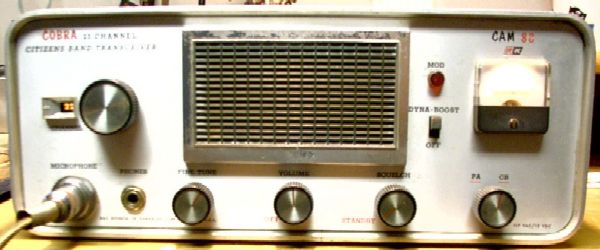
Cobra Cam 88
by Spitfire, 441

This is a review of the B&K Cobra CAM 88. I believe this to be Cobra's first radio as well as my first tube CB rig. This review is of the CAM 88 that is known as the "Low Key" 88 (named after the previous owner's handle). This radio was first discussed in the Tale of Three Cobras. I wonít go much into the restoration details here, as they have already been covered. Instead, I will get into the specifics of its performance since restoration.
Out of the two CAM 88ís I have left, this one is the best performer. I am now very happy with this rig after many capacitor and tube replacements. This radio started out in bad electrical condition but with a clean exterior. The interior required much cleaning to remove tarnish and corrosion, especially the tube sockets. Quite a bit of early trouble with the rig was found to be intermittent type problems related to the sockets. After some tube replacement this rig became a real good transmitter. Maybe those Electroharmonix Russian tubes arenít so bad after all. I have been told it's real loud and full with the "Dyna Boost" on. The audio is sort of anemic and stock with the "Boost" off. All of this high level plate modulated audio is achieved using an un-amplified D104 UG8 stand.
The rig has that expected tube big full audio sound on receive as well. After all the work I have done to this radio, it has paid off well. I am very happy with the radio as an everyday, any day, performer. I can see why this radio was in production for at least 6 years. Not everything is peaches and cream though. One soft spot is its selectivity. The front end tends to be a little broad for very good adjacent channel rejection. However thatís usually not a problem with the typically empty channels above and below where I normally operate.
The features on the rig are pretty basic. Volume, Squelch, Fine Tune, "Dyna Boost", and PA/CB switch. The Fine Tune is nice as it is a continuously variable capacitor instead of a switched +/-. The fine tune is good for about 2.5kc of shift +/-. The modulation light presents a good indication of output modulation. The "Sí meter does a fair job of displaying relative signal level, but it is not too linear. It seems tight in the 1-5 range and loosens up more as it goes up. The power output meter is pretty much on. The meter is of a good size to be easily read. I also like the way the meter is backlighted instead of lit from the front.
Now for the bench numbers:
Receiver:
Sensitivity: .26uV for 10db S+N/N
Adjacent channel selectivity: 35db @ 10Khz.
IF: 1st 37.5 Mhz, 2nd 475khz.
Transmitter:
AM Power: 3.5 watts with forward swing.
AM Modulation: 100+%
2nd harmonic suppression: -50db+
Other spurious emissions: -50dbc.
I would recommend this rig for every day use. The burnished all aluminum face of the radio is a real pleasure to look at too. Plus, they are plentiful and relatively cheap. Best of all, they are easy to work on with no-nonsense, straightforward circuitry.